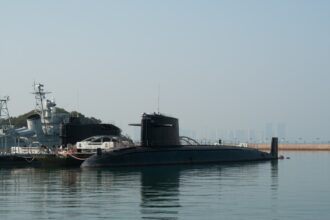The V-2 rocket program, a pivotal chapter in the history of aerospace technology, traces its origins back to the interwar period in Germany. Following World War I, the Treaty of Versailles imposed severe restrictions on German military capabilities, including the development of advanced weaponry. However, this did not stifle the ambitions of German engineers and scientists who were fascinated by rocketry.
In the 1920s and 1930s, a small group of visionaries, including Hermann Oberth and Wernher von Braun, began to explore the potential of rocket propulsion. Their work laid the groundwork for what would eventually become the V-2 program. As the political landscape shifted in Germany with the rise of the Nazi regime, the government began to take a keen interest in rocketry as a means of military advancement.
The regime’s desire for technological superiority led to increased funding and support for research in this field. By the late 1930s, the German military recognized the potential of long-range missiles, and the V-2 project was officially initiated under the auspices of the Army Ordnance Office. This marked a significant turning point, as it transformed theoretical research into a concerted effort to develop a weapon that could strike targets far beyond conventional artillery range.
Key Takeaways
- The V-2 rocket program was developed by Nazi Germany during World War II as a weapon of mass destruction.
- Wernher von Braun played a key role in the V-2 program, leading the development and testing of the rocket.
- The construction and testing of the V-2 rocket involved the use of slave labor, resulting in significant human rights violations.
- The V-2 rocket had a significant impact on World War II, causing widespread destruction and civilian casualties.
- The V-2 rocket’s influence on post-war space exploration paved the way for advancements in rocket technology and space travel.
The Role of Wernher von Braun in the V-2 Program
Wernher von Braun emerged as a central figure in the V-2 rocket program, his brilliance and vision propelling the project forward. Initially captivated by the idea of space travel, von Braun’s early work focused on theoretical rocketry. His expertise caught the attention of military officials, and he was appointed as the technical director of the V-2 project.
Under his leadership, the program flourished, benefiting from his innovative ideas and relentless pursuit of perfection. Von Braun’s ability to navigate the complexities of engineering and military demands made him an invaluable asset to the project. Despite his significant contributions to the V-2 program, von Braun’s legacy is complicated by his association with the Nazi regime.
He was aware of the ethical implications of his work but remained focused on achieving technological breakthroughs. His leadership style fostered a culture of creativity and collaboration among engineers and scientists, which ultimately led to remarkable advancements in rocket technology. Von Braun’s vision extended beyond military applications; he dreamed of exploring space, a passion that would later shape his post-war career in America.
The Construction and Testing of the V-2 Rocket

The construction and testing phases of the V-2 rocket program were marked by both innovation and challenges. The design of the V-2 was groundbreaking, featuring a liquid-fueled propulsion system that allowed it to reach altitudes of over 180 kilometers. The rocket’s aerodynamic shape and guidance system were revolutionary for their time, enabling it to travel at speeds exceeding 5,700 kilometers per hour.
However, translating these ambitious designs into reality required overcoming numerous technical hurdles. Testing was an essential component of the V-2 program, with early trials conducted at various sites across Germany. The first successful launch occurred in 1944 at Peenemünde, where engineers meticulously monitored every aspect of the rocket’s performance.
These tests provided critical data that informed subsequent designs and improvements. However, they were not without setbacks; many early launches ended in failure due to technical malfunctions or design flaws. Each failure was met with determination, as engineers analyzed the results to refine their approach, ultimately leading to a more reliable and effective weapon.
The Impact of the V-2 Rocket on World War II
| Aspect | Impact |
|---|---|
| Technology | The V-2 rocket was the world’s first long-range guided ballistic missile, representing a significant advancement in military technology. |
| Casualties | It caused significant civilian casualties in London and Antwerp, leading to the loss of thousands of lives. |
| Psychological impact | The V-2 attacks caused fear and anxiety among civilians, leading to psychological trauma and disruption of daily life. |
| Strategic impact | The V-2 attacks had a limited strategic impact on the outcome of the war, as they did not significantly alter the course of the conflict. |
| Post-war influence | The V-2 rocket technology became the basis for future developments in space exploration and missile technology during the Cold War era. |
The introduction of the V-2 rocket had a profound impact on World War II, altering the dynamics of warfare in Europe. As one of the first long-range guided missiles, it represented a significant leap in military technology. The V-2 was capable of striking targets hundreds of kilometers away with unprecedented accuracy, instilling fear in Allied forces and civilian populations alike.
Its deployment marked a new era in warfare, where conventional artillery was overshadowed by advanced missile technology. The psychological impact of the V-2 rocket was considerable. As cities like London faced bombardment from these rockets, morale among civilians and military personnel began to waver.
The unpredictability of V-2 attacks created an atmosphere of anxiety and uncertainty. While its military effectiveness was limited due to logistical challenges and resource constraints, the psychological warfare aspect proved to be a powerful tool for Nazi propaganda. The V-2 became a symbol of German technological prowess, even as its actual contribution to the war effort remained contentious.
The Use of Slave Labor in the V-2 Rocket Program
A dark chapter in the history of the V-2 rocket program is its reliance on slave labor for construction and assembly. As production ramped up to meet military demands, the Nazi regime turned to forced labor from concentration camps to staff factories like those at Mittelwerk. Thousands of prisoners endured horrific conditions while working on the assembly lines, facing malnutrition, abuse, and high mortality rates.
This exploitation highlights a grim reality behind one of history’s most significant technological advancements. The use of slave labor not only raises ethical questions about human rights violations but also casts a shadow over the achievements of German engineers like von Braun. While they were celebrated for their technical innovations, many were complicit in a system that dehumanized countless individuals for their own gain.
The legacy of this exploitation continues to resonate today, reminding society that technological progress must be weighed against moral considerations.
The V-2 Rocket’s Influence on Post-War Space Exploration

Following World War II, the technological advancements achieved through the V-2 rocket program laid crucial groundwork for future space exploration endeavors. As Allied forces captured German scientists and engineers, including Wernher von Braun, they recognized their potential contributions to aerospace technology. Von Braun’s expertise became instrumental in shaping America’s space program during the Cold War era.
The principles developed during the V-2 program informed subsequent rocket designs used in early space missions. The knowledge gained from liquid-fueled propulsion systems and guidance technologies directly influenced projects like NASA’s Redstone and Saturn rockets. Von Braun’s vision for space travel became a reality as he transitioned from military applications to peaceful exploration, ultimately leading to humanity’s first steps on the Moon.
The Allied Efforts to Counter the V-2 Rocket Attacks
In response to the threat posed by V-2 rocket attacks, Allied forces undertook significant efforts to counter this new form of warfare. Intelligence operations aimed at understanding the technology behind the rockets became paramount. Allied scientists worked tirelessly to analyze captured V-2 components and reverse-engineer their designs.
Additionally, military operations were launched to disrupt V-2 production facilities and launch sites. Air raids targeted Peenemünde and other key locations in an attempt to cripple Germany’s ability to produce these weapons.
Despite these efforts, V-2 attacks continued until late in the war, demonstrating both the resilience of German engineering and the challenges faced by Allied forces in countering this advanced technology.
The Legacy of the V-2 Rocket Program
The legacy of the V-2 rocket program is multifaceted, encompassing both technological advancements and ethical dilemmas. On one hand, it represents a significant milestone in aerospace engineering that paved the way for future developments in rocketry and space exploration. The innovations born from this program laid foundational principles that continue to influence modern missile technology.
Conversely, the program serves as a stark reminder of how scientific progress can be intertwined with moral failings. The exploitation of slave labor during its production raises critical questions about accountability and ethics in technological advancement.
The Ethical and Moral Implications of the V-2 Rocket Program
The ethical implications surrounding the V-2 rocket program are profound and complex. While it showcased remarkable engineering feats that contributed significantly to modern rocketry, it also involved grave human rights violations through its reliance on forced labor. This duality presents a moral quandary: how can society celebrate technological progress when it is built upon suffering?
Moreover, von Braun’s involvement raises questions about individual responsibility within larger systems of oppression. His contributions to space exploration are undeniable; however, they are inseparable from his role within a regime that perpetrated atrocities against humanity. This tension invites ongoing discourse about ethics in science and technology—how can future innovations be pursued without repeating past mistakes?
The V-2 Rocket’s Impact on Modern Missile Technology
The influence of the V-2 rocket extends far beyond its immediate historical context; it has shaped modern missile technology in profound ways. Many contemporary missile systems draw upon principles established during its development—liquid propulsion systems, guidance mechanisms, and aerodynamic designs can trace their lineage back to this pioneering project. Furthermore, lessons learned from both its successes and failures have informed military strategies worldwide.
The concept of long-range precision strikes has evolved significantly since World War II but remains rooted in early innovations like those found in the V-2 program. As nations continue to develop advanced missile technologies today, they stand on the shoulders of giants who navigated uncharted territories during an era defined by conflict.
The V-2 Rocket’s Continued Influence on Science and Technology
The legacy of the V-2 rocket program continues to resonate within contemporary science and technology fields beyond military applications. Its pioneering work laid essential groundwork for advancements in aerospace engineering that have enabled humanity’s exploration beyond Earth’s atmosphere. From satellite launches to interplanetary missions, many modern endeavors owe their success to principles established during this early phase of rocketry.
Moreover, as society grapples with ethical considerations surrounding technology today—such as artificial intelligence or genetic engineering—the lessons learned from programs like that of the V-2 serve as cautionary tales about accountability and responsibility in scientific pursuits. The duality inherent in such advancements reminds us that progress must be pursued with vigilance toward its broader implications for humanity. In conclusion, while celebrating achievements born from innovation is vital for progress, it is equally important not to forget those who suffered along this journey toward discovery—ensuring that future advancements honor both human dignity and scientific integrity alike.
The untold story of the V-2 rocket is a fascinating chapter in the history of warfare and technology, shedding light on the innovations and challenges faced during its development. For those interested in exploring more about the intricacies of wartime technology and strategy, a related article can be found on the War Room’s website. This article delves into various aspects of military history and provides a broader context to the technological advancements of the era. You can read more about these intriguing topics by visiting the following link: War Room.
WATCH THIS! 🪖How Stolen Nazis Built Cold War Power
FAQs
What is the V-2 rocket?
The V-2 rocket, also known as the A-4, was the world’s first long-range guided ballistic missile. It was developed by Nazi Germany during World War II and was the first man-made object to reach the edge of space.
What was the purpose of the V-2 rocket?
The V-2 rocket was developed as a weapon of war and was used by Nazi Germany to attack Allied cities, primarily London and Antwerp, during World War II. It was intended to be a strategic weapon to demoralize and disrupt the enemy’s war effort.
Who developed the V-2 rocket?
The V-2 rocket was developed by a team of German engineers led by Wernher von Braun at the Peenemünde Army Research Center. It was part of Nazi Germany’s secret weapons program and was developed under the supervision of the German Army.
How was the V-2 rocket powered?
The V-2 rocket was powered by a liquid-fueled rocket engine, which used a combination of ethanol and liquid oxygen as propellants. This allowed the rocket to reach speeds of up to 5,760 km/h (3,580 mph) and to travel a distance of approximately 320 kilometers (200 miles).
What impact did the V-2 rocket have on the war?
The V-2 rocket had a significant impact on the war, as it was the first long-range guided ballistic missile and represented a major technological advancement in warfare. It caused widespread destruction and casualties in the cities it targeted, and its development laid the groundwork for future advancements in rocket technology.
What was the untold story of the V-2 rocket?
The untold story of the V-2 rocket includes the experiences of the forced laborers and prisoners of war who were used to build and launch the rockets, as well as the impact of the V-2 attacks on civilian populations. It also includes the post-war use of V-2 technology by the United States and the Soviet Union in their space programs.




